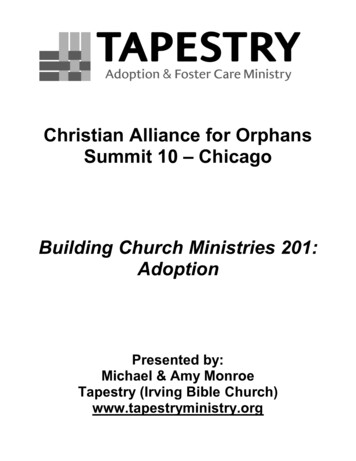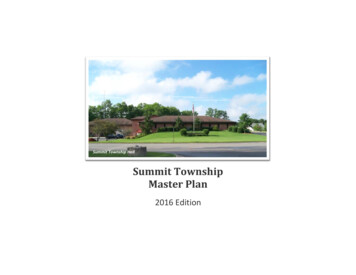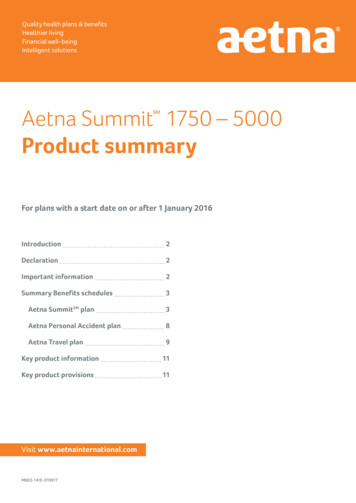
Transcription
Christian Alliance for OrphansSummit 10 – ChicagoBuilding Church Ministries 201:AdoptionPresented by:Michael & Amy MonroeTapestry (Irving Bible Church)www.tapestryministry.org
1
2
Key Questions Every Adoption Ministry Leader MustAsk & Answer1. What are your Motivations for leading and serving in church adoptionministry? In other words, why are you doing what you do?2. What is the Mission/Purpose for your church adoption ministry?3. What are the Long-Term Goals for your church adoption ministry?4. What are your Short-Term Goals for your church adoption ministry?5. How will you measure Success in terms of church adoption ministry?6. What are the Specific Actions that need to plan and take in the next sixmonths to begin to accomplish your goals?7. What Resources & Training will you need?8. Who are the Helpful People that you will need to involve or rely upon?Copyright Tapestry, a ministry of Irving Bible Church3
So Now What Do We Do?Practical Ideas for Adoption and Foster Care MinistriesBy Michael MonroeIt is exciting to see more and more church adoption and foster care ministries beinglaunched. There are many helpful resources available to help new church ministries asthey get started – and we have compiled some great ones on the Tapestry website. Butas we talk with ministry leaders from around the country who have launched or are justabout to launch church ministries we hear one question over and over: so now what dowe do?What these leaders are finding out is that launching an adoption or foster care ministryis one thing, but creating and developing ways to effectively connect, encourage andinform families is entirely another. It takes a continual supply of fresh ideas toeffectively meet the needs of the parents and children connected to your ministry and tofulfill your ministry’s God-given vision. So we want to share with you several practicalideas that we believe will be helpful as your ministry moves forward.1. Think Big . . . While Keeping it Small – Many church ministries start by thinkingBIG – big plans, big events, big crowds and big impact. While it is generally good to“think BIG,” we think one of the “biggest” ideas an effective adoption or foster careministry can pursue is to create safe, small group environments for people toconnect and find encouragement. Consider starting a playgroup for moms and kidsor a small group for waiting families as a way to connect those in the same stage ofthe adoption or foster care journey. You might also consider organizing a night outfor moms and moms-to-be at a local coffee shop as a great opportunity for women totalk about the unique joys and challenges of the adoption or foster experience.2. Identify Needs and Respond – We have learned that often the most effectiveactivities and events come from simply identifying the needs of those in your churchand your community and then responding. For example, it may be that manycouples in your church have questions and even fears about adoption based on themany myths of adoption that they so frequently encounter. In response, anexperienced adoptive family can prepare an educational talk to present qualityinformation about the true realities of adoption. If you don’t know where to find thistype of information, contact us and we will be happy to send you our materials.3. Stories, Stories, Stories – Stories have a way of connecting with hearts and minds.Find forums, both large and small, to allow families in your church or ministry to telltheir story as a way to inform and encourage others. But be sure you know a little bitabout each story that will be shared so that those who hear these stories leave witha realistic and accurate picture of adoption and foster care – and most of all with asense of hope.4
4. Always Make Time to Celebrate – Sometimes the best way to “do adoption andfoster care ministry” is simply to throw a party. Women in our ministry often gettogether to have a “sprinkle” (i.e., a mini-shower) for moms welcoming a baby oryoung child into their family or finalizing the adoption of a child from foster care.Many of our families also like to party at the airport baggage claim as we welcomehome families arriving with their children adopted internationally or from out-of-state.5. Continue to Learn While You Serve – It is important to be well informed about theadoption and foster care landscape so that you can serve families and children well.Take time to locate quality, reliable resources and information that will help youbecome educated about aspects of the adoption and foster care world that you maynot have directly experienced. For example, you may have adopted internationallybut your ministry seeks to also serve foster families and those who have adoptedfrom state foster care. As a result, it may be important to learn some basics aboutthe foster care system so that you can better understand and serve foster familiesand those considering that path. Be sure to let us know if you would like help infinding these types of quality educational resources.6. Don’t Forget About the Guys – It is important not to forget about the guys whenplanning adoption and foster care ministry events. It is equally important to considerthat guys generally connect in a completely different way than women. As a result,playgroups and coffee shop chats won’t likely be very popular with the guys. But wehave found that a monthly burger night (at a new burger joint each month) is a greatexcuse for guys to get together and talk about adoption and whatever else is on theirminds.7. Having Fun is Ministry Too – Periodically we plan an event with a single purposein mind: to simply allow our families to have fun. We have previously rented a jumphouse playground to let the kids (and kids at heart) run and play, and for the pasttwo summers our families have come together at a small, local water park to swimand have fun. These family fun events have proven to be a great way for parentsand children to connect and enjoy being together.8. Importance of Family-to-Family – We have learned that there is simply nosubstitute for families considering or exploring adoption or foster care being able tospend time with families that have already successfully navigated these paths.Experienced families in our ministry often invite pre-adoptive couples over for dinneror coffee and dessert in order to listen, answer questions, offer encouragement andpray. While large group events and impressive programs can certainly be helpful,we have consistently found that one-on-one love and care is always important inorder for couples and families to experience the support and encouragement they sodesperately want and need.Copyright 2007 Tapestry, a ministry of Irving Bible Church5
Tapestry Discussion GroupsBelow is a list of the types of regular discussion groups that Tapestry hashosted over the past nine years. Typically, each discussion group meetsonce each month. Each is led or facilitated by an experienced couple orprofessional in some cases, and all discussion groups are open to anyonein or outside of the church. Waiting Families Groups Playgroup Moms (and Moms-to-Be) Nights Dads (and Dads-to-Be) Nights Foster Care Support Group Older Child Adoption Parent Discussion Group Older Child (Ages 13-18) Adoption Discussion Group Birthmother Support Group Adult Adoptee Support Group Empowered To Connect Parent Discussion GroupGo to oups to find outmore about Tapestry’s discussion groups.6
Ground Rules for Tapestry Discussion GroupsThings to remember to help us stay on track . . . Be real but be positive – we call it “real hope” and we know that’swhat we all want and need Be willing to own your own stuff – what we as parents bring to thetable is just as important (if not more so) as the challenges we facewith our children, so we must always be willing to focus on ourselveseven as we deal with our children and their issues Protect your child’s privacy – what we discuss in this group is sharedin confidence, but at the same time we must always be mindful toprotect our children’s stories Do not criticize agencies or professionals by name – if you need helpin communicating or working through an issue with your agency orother professional, please let us know and we will be happy to help;however, this group is not the right place to criticize agencies orprofessionals Stay on topic – if we have chosen a discussion topic that is of interestto everyone in the group, then it is important for us to stay on topic sothat the conversation is relevant and helpful to everyone Allow others to speak – this group is intended to facilitate discussion,so please be sure to allow time for everyone to participate7
Strategy Guide:Tapestry Waiting Families GroupsNeed, Vision and Description of Strategy: The adoption (and foster care) waitingstage can be one of the most difficult times during the adoption journey. It is a time thatis filled with questions and doubts and, frankly, it is a time that too few non-adoptivefamilies understand or can directly relate to. In addition, many families seeking to adoptare now facing increasingly longer and more difficult waits than in years past. As aresult, we have created a small group specifically for those who are in the midst of theadoption (or foster care) wait. We believe that those who are waiting should seek to“make the wait worthwhile” and this group is designed to help them to do just that. Ledby an experienced adoptive couple, this group helps waiting families know that they arenot alone and gives them the opportunity to connect with others who are also waiting sothat they can pray with and for each other, support one another, learn from one anotherand, ultimately, celebrate with one another once the wait has come to an end. Tapestryhas two separate waiting families groups each led by a separate lead couple.Steps to Implementation: Identify waiting families who desire to be connected with one another or whocould benefit from the support of other waiting familiesIdentify an experienced adoptive family that is willing and able to shepherd andserve waiting families that are pursuing various types of adoption journeys (e.g.,international, domestic, foster/adoption, etc.)Find a date, time and location that works (Tapestry hosts each waiting familiesgroup at the respective lead couple’s home – one on the 1st Saturday evening ofeach month and the other on the 4th Saturday evening of each month)Get the word out (Tapestry uses its website, email list and other churchcommunications to make people aware of the waiting families group; we also letlocal adoption agencies know about the group so that they can refer families whomight benefit)Decide on a format (Tapestry serves dessert and coffee and then has a lightlystructured facilitated discussion, sometimes involving a specific topic; childcare isnot provided). Be committed to follow-up with each person who attends the8
group. While this can be time consuming and, at times, intensely pastoral, it iscritical that the group be more than just a social gathering, and instead offercommitted support, encouragement and true community.Key Role(s) and (Title(s): Each Tapestry waiting families group is led by one or morelead couples that have adoption experience and have the heart and wisdom toshepherd and serve waiting families. It is important that the lead couple is willing andable to walk alongside those pursuing various types of adoption journeys, not just thesame path that the lead couples has experienced. It is also important that the leadcouple is willing and able to follow-up, support and pray for families between theperiodic group meetings.Expected Financial Cost: Very little (Tapestry serves desserts and coffee that issupplied by the lead couple). Periodically the waiting families group will also have adinner event, such as a Christmas party or a Memorial Day cookout.Potholes to Avoid: Do not allow group meetings to become “therapy” or “gripe” sessions about theadoption process, the waiting stage or adoption agencies (always focus onencouraging families and offering them hope and something positive)Do not allow group members to scare others with stories or experiences that are“extreme” or “sensationalized” (always provide context and perspective withoutignoring the real challenges that are often encountered both during the waitingstage and after placement)Do not ignore or minimize the reality that the waiting stage can be difficult (thewait is often difficult and this is a group that should be understanding of thatreality while at the same time helping people to find ways to make the most of itand redeem the time)Seriously consider not having children present when the group meets as it canbe disruptive to the group dynamic and may cause couples who do not yet havechildren to feel uncomfortable or out of placeHelpful Resources: Tapestry’s Waiting Families s-groupsAnthony and Kristin Violi, Leaders of Tapestry’s Waiting Families Groups(email: ktvioli@gmail.com)Adoptive Families Magazine Special Section: “While You 9
Quotes from participant or Other Thoughts: "We’ve really been encouraged by other people's stories meeting people inthe same spot we’re at and having a group of friends we know will be excited inall the right ways when our child finally comes home" From Romans 8 (The Message): “That is why waiting does not diminish us, anymore than waiting diminishes a pregnant mother. We are enlarged in the waiting.We, of course, don't see what is enlarging us. But the longer we wait, the largerwe become, and the more joyful our expectancy. Meanwhile, the moment we gettired in the waiting, God's Spirit is right alongside helping us along. If we don'tknow how or what to pray, it doesn't matter. He does our praying in and for us,making prayer out of our wordless sighs, our aching groans. He knows us farbetter than we know ourselves, knows our pregnant condition, and keeps uspresent before God. That's why we can be so sure that every detail in our lives oflove for God is worked into something good.”*Go to ces/strategy-guides to find linksto all of the Tapestry strategy guides.Copyright 2008 Tapestry, a ministry of Irving Bible Church10
What Every AdoptiveParent Should KnowFeaturing Dr. Karyn PurvisConsists of eight short video sessions covering some of thebasics that every adoptive and foster parent needs to know.Topics:1. Children from Hard Places2. Focusing on the Whole Child3. Looking at Ourselves to Help Our Children Heal4. The Impact of Fear5. The Importance of Giving Voice to Children6. Understanding Sensory Processing7. Parenting Strategies that Connect8. The IDEAL Response for ParentsAll content also available free online at: empoweredtoconnect.org11
10 Questions Adoptive Parents AskFeaturing Dr. Karyn Purvis & Michael MonroeVideo Topics:1.2.3.4.5.6.How Do I Handle Manipulation & Control?Will Trust-Based Parenting Work for My Child?Why Won’t My Child Act His Age?How Do I Handle Lying?How Do I Find the Right Professional To Help Us?Should I Parent My Adopted Child Differently ThanBirth Children?7. How Long Do I Have to Parent This Way?8. Is It Adoption Related or Not?9. Will Trust-Based Parenting Prepare My Child forthe Real World?10. How Can I Be Fair?This content is also available free online at:empoweredtoconnect.org12
Insights & Gifts Video SeriesFeaturing Dr. Karyn PurvisConsists of short (2 to 5 minute) video sessions divided into7 insights and 7 gifts plus an online discussion guide.Designed primarily for discussion group .Insight: Explore Your ExpectationsInsight: Simplify Your LifeInsight: Provide Familiarity and ContinuityInsight: Be Fully PresentInsight: Expect Long-Term ChallengesInsight: Embrace the Complex Needs of Your ChildInsight: Create a Balance of Nurture & StructureGift: Give Your Child VoiceGift: Give Your Child NurtureGift: Give Your Child Shared PowerGift: Give Your Child PredictabilityGift: Give Your Child Permission to Process FeelingsGift: Give Your Child PlayfulnessGift: Give Your Child Healthy Parents with Good Self-CareAll content also available free online at:empoweredtoconnect.org13
Resource List The Connected Child, by Karyn Purvis, David Cross and Wendy Sunshine Created to Connect: A Christian’s Guide to The Connected Child, by KarynPurvis and Michael & Amy Monroe Wounded Children, Healing Homes: How Traumatized Children Impact Adoptiveand Foster Families, by Jayne E. Schooler, Betsy Keefer Smalley, Timothy J.Callahan Anatomy of the Soul, by Curt Thompson, M.D. Parenting from the Inside Out, by Daniel Siegel and Mary Hartzell The Whole-Brain Child, by Daniel Siegel and Tina Payne Bryson Attaching in Adoption, by Deborah Gray Nurturing Adoptions: Creating Resilience After Neglect and Trauma, by DeborahGray The Out-of-Sync Child (Revised Ed., 2006), by Carol Kranowitz The Out-of-Sync Child Has Fun: Activities for Kids with Sensory ProcessingDisorder (Revised Ed., 2006), by Carol Kranowitz Parenting Is Your Highest Calling: And Eight Other Myths That Trap Us in Worryand Guilt, by Leslie Leyland Fields TCU Institute of Child Development DVDs (available for purchase atwww.child.tcu.edu) Empowered To Connect (videos, audio and articles available for free downloadat www.empoweredtoconnect.org)14
Empowered To ConnectAdoptive & Foster Parent TrainingOverviewEmpowered To Connect (ETC) Parent Training is an interactive learning experiencedesigned specifically for adoptive and foster parents. The ETC Parent Training wasdeveloped by Michael & Amy Monroe and relies heavily on the Trust-Based RelationalIntervention (TBRI) model developed by Dr. Karyn Purvis and her colleagues at theTCU Institute of Child Development (www.child.tcu.edu).ETC Parent Training equips parents with a holistic understanding of their child’s needsand development while empowering them with the tools and strategies to effectivelymeet those needs, build trust, and help their child heal and grow. The training is taughtfrom a Christian perspective and focuses on a wide range of topics and issues relevantto adoptive and foster parents, including helping parents understand the impact of theirchild’s history, what they themselves bring to the parent-child relationship, thefundamentals of attachment, the impact of fear, and the importance of meeting theirchild’s sensory processing, nutritional and other physiological needs.Ultimately, ETC Parent Training integrates this holistic understanding with the insightsand skills parents need to effectively and consistently employ a balanced parentingapproach that allows them to provide compassionate discipline that both connects andcorrects.Session Topics & Training RequirementsEmpowered To Connect Parent Training is divided into two separate courses: thePrepare Course (for pre-placement couples and singles) that meets for six weeks, andthe Connect Course (for post-placement couples and singles) that meets for nineweeks. Each course is taught in interactive small groups that meet weekly for two hoursessions.15
The Connect Course includes the following nine sessions designed for parents whohave already adopted: Building a Foundation of ConnectionUnderstanding What Your Child Brings to the RelationshipExamining What You Bring to the Relationship (Part 1)Examining What You Bring to the Relationship (Part 2)Exploring the Heart of Connection – AttachmentFocusing on the Needs of the Whole ChildPutting It All Together: Connecting While Correcting (Parts 1-3)During the in-class sessions participants cover the above material contained in the ETCParent Training Manual. In addition, the in-class sessions are supplemented byweekly assignments, including reading and a variety of “at-home” exercises.History of ETC Parent TrainingETC Parent Training was developed and first taught by the Monroe’s in 2010 at IrvingBible Church. Since then, over 200 families have completed the training. ETC ParentTraining is offered regularly by Tapestry (at Irving Bible Church) for families in theDallas/Ft. Worth area. In addition, over 90 couples from around the U.S. havecompleted Empowered To Connect Train-the-Trainer, and many are starting to leadETC Parent Training in their own church.Empowered To Connect Train-the-TrainerEmpowered To Connect Train-the-Trainer is an eight week training process for marriedadoptive or foster couples. The first seven weeks of train-the-trainer are conducted viaremote learning utilizing reading assignments, DVD instruction and a variety of writtenand participatory exercises. The training concludes with a three day intensive in-classtraining led by Michael & Amy Monroe typically at Irving Bible Church in Irving, Texas.Empowered To Connect Train-the-Trainer is offered several times each year and isopen to experienced adoptive/foster parents that are involved in establishedadoption/foster ministries. In order to ensure the quality and effectiveness of the trainthe-trainer experience, class sizes are limited and both spouses are required to attendtrain-the-trainer together. Go to http://goo.gl/0XPPjB for some helpful FAQs about theETC Train-the-Trainer.For ProfessionalsIf you are a professional wanting to be trained in your professional capacity, please visitthe TCU Institute of Child Development website at http://www.child.tcu.edu/training.aspto learn more about Dr. Purvis’ Trust-Based Relational Interventions (TBRI) Training forprofessionals.16
No One Said This Would Be EasyChallenges to Expect in Adoption and Foster Care Church MinistryBy Michael MonroeAdoption and foster care ministry in the church is not easy. There, we said it. We knowit may not be the most “encouraging” thing you have ever heard – but it’s honest. Andthe sooner we all accept this reality the better.We hear a lot of different comments and reactions as we talk with people in churches allacross the country about their experience in starting or leading an adoption or fostercare ministry. But something we have never heard anyone say is, “Wow, this sure iseasy!”You’ve heard it said that few things in life worth doing are easy. Well that has certainlybeen true for us as we have passionately pursued our God-given calling to serve andlove the ‘fatherless’ by helping to create a community of adoptive and foster families.And yet, there is a certain amount of comfort, freedom and, yes, even encouragement inaccepting that there will be challenges. In fact, we view many of these challenges asconfirmation that individually, as followers of Christ, and collectively, as a ministry in ourlocal church, we are traveling (however imperfectly at times) the road that God has setbefore us.To help you as you move forward with your church ministry we have compiled just a fewof the significant challenges that we have faced along the way. Your ministrychallenges may be similar to ours or you may face different obstacles. Either way, weare convinced that the journey itself is part of the blessing, and having an idea of whatto expect can often allow you to prepare better and respond more effectively. Even so,we are convinced that you will see the redemptive love of God at work as He formsfamilies and transforms lives through the miracle of adoption – and as He works in andthrough the local church to help accomplish this end. That has certainly been ourexperience . . . and it has all been worth it. So from our point of view – bring on thechallenges.Common Challenges for Adoption and Foster Care Church Ministries:1. Getting key leadership on board – Of all the frustrations and disappointmentschurch ministry leaders face, this is probably the most frequent and acute. Wehave many thoughts on this particular challenge, as it is one that we faced earlyon. But the bottom line is this: if we are honest, the lack of support from keychurch leadership (whether real or perceived) is probably not holding us backfrom passionately pursuing God’s call to adoption ministry. Instead, most often itis entirely possible to “wait without standing still.” In other words, there is muchthat you can do even as you wait for leadership to fully embrace the vision andpotential of your ministry.17
2. Who’s serving who? – As you move forward with your church ministry plansyou are certain to encounter many agencies and other organizations wanting todiscuss how the church ministry can help them further their efforts. In essence,these agencies and organizations, many of them Christian, are looking to thechurch ministry as a potential resource rather than being a resource for theministry. This is not to say that there aren’t effective ways that agencies andchurch ministries can work together – there certainly are. But if the churchministry is to identify and fill the critical needs that only it can serve, it is importantthat the primary focus remain the church ministry – not the other way around.3. Saying no to the “good” in order to focus on the “best” – There is simply noshortage of good, if not great, ideas that your ministry team will come up with asyou move forward. Yet because most church adoption and foster care ministriesare largely volunteer-led, there are likely real limitations on how many of thoseideas and plans can be effectively carried out. As a result, most ministries arefaced with having to prioritize what they can do “best” and what is needed “most”in order to serve well and make a lasting difference in the lives of children andfamilies.4. People wanting a “tailored just for me” ministry – You won’t have to dochurch adoption or foster care ministry long before you run into those who arelooking for a ministry that is all about them. Their issues, their interests, theirparticular path . . . me, me, me. Don’t be shocked when this happen – and don’tgive in. You simply will not please everyone, and arguably you shouldn’t try.The truth is that the vast majority of our families see tremendous value in beingconnected with other adoptive and foster families even if every event, everystory, every everything is not tailored just for them.5. Resisting the temptation to take shortcuts – Adoption and foster care ministryin the church context can be intensely time consuming and demanding. As aresult there is always the temptation to take shortcuts. Shortcuts such as takinghelp from just any family even when that family is not truly ready to serve otherfamilies; letting someone speak at an event without first having a general idea ofwhat they will say and whether it is accurate, hopeful and helpful; or allowing anagency to push a single adoption path even though it may not be right foreveryone. Even if it means slowing down your plans or seeking out other churchministries for advice and help, be sure to resist the temptation. We have learnedthat there are no shortcuts worth taking.6. Do I have to tell them that? – The answer is usually “yes.” The undeniabletruth is that there are some very hard realities to the adoption and foster carejourney, and making everything seem rosy and wonderful is only likely to lead tomuch frustration, heartache and pain. We have learned that people place a veryhigh value on honesty and being told that the adoption and foster care journeyswill likely not be easy. We do not deny that there will be “miracle moments” and18
indescribable joys along the way, but there will also be real challenges,frustrations and hurts as well. So be honest, be open and be willing to presentthe hard realities along with the hope and support that a church ministry canprovide.7. Money & Adoption: Mix carefully – The financial burden associated withadoption is overwhelming for many families. In response, many church ministriesestablish financial assistance funds or identify other ways to help familiesshoulder the financial costs of adoption. These are important aspects of being awell-connected community of families, and yet mixing money and adoption canoften create unusual dynamics and unintended consequences. Therefore, it isvery important to carefully think through and pray about how to handle thisaspect of the adoption journey so that these two realities are mixed together in away that is positive for everyone in the ministry and the church as a whole.8. Accepting the fact that not everyone will “get it” – Just take a deep breathand repeat ten times, “Not everyone will get it . . . and that’s ok.” You can fight it,you can deny it, you can ignore it – but it is still true. It is tempting to sometimesthink that a major part of a church adoption or foster care ministry is making sureeveryone at the church (and beyond) “gets it.” Don’t get me wrong, it would begreat if they did and we should pray and work to that end. But when they don’t(and some won’t) it is important to stay the course and go about being a loving,supportive community of families that model the blessing and miracle of adoption. . . whether others “get it” or not.Copyright 2008 Tapestry, a ministry of Irving Bible Church19
If It Ain’t No, Then GoBy Michael MonroeI’ve heard it dozens of times from church volunteers and lay leaders alike. They recount,often in frustrated tones, how their pastor or some other key church leader doesn’tseem to understand or isn’t “on board” with their ideas and dreams for an adoption orfoster care ministry. In response I typically offer the reassurance that they are not alone.Our experience is that most new church adoption, foster care and orphan careministries encounter similar reactions and responses.However, as I think back about the journey that our ministry has traveled over the lastthree years, I realize that we have gained some very valuable insights that I believe canbe encouraging and instructive for others. We can be
Summit 10-Chicago Building ChurchMinistries 201: Adoption Presented by: Michael & Amy Monroe Tapestry (Irving Bible Church) www.tapestryministry.org. 1. 2. 3 . local adoption agencies know about the group so that they can refer families who might benefit) Decide on a format (Tapestry serves dessert and coffee and then has a lightly .










